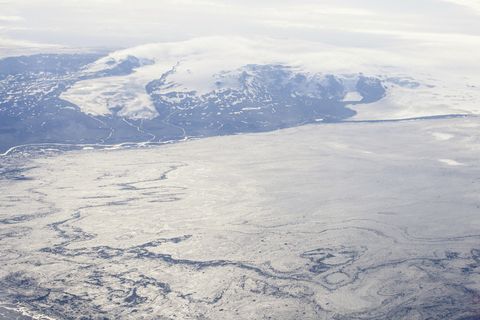20 million cubic meters of magma added
The Bárðarbunga area.
mbl.is/Árni Sæberg
The dyke intrusion beneath Dyngjujökull is thought to be about 40 km in length and modelling of GPS data indicates that about 20 million cubic metres of magma have been added to the volume of the intrusion in the last 24 hours. These are some of the Scientific Advisory Board's conclusions after a meeting this morning.
The meeting's conclusions are as follows.
- Intense seismicity continues. Over 700 earthquakes have been recorded since midnight. Earthquakes are occurring mostly beyond the edge of the Dyngjujökull glacier and the intrusion itself has migrated about 1 km northwards since yesterday.
- At 00:16 UTC today, a magnitude 5.3 earthquake occurred in the caldera of Bárðarbunga. At 02:50 UTC, another similar-sized earthquake (magnitude 5.2) took place in the same region.
- At 01:52 UTC, a magnitude 4.5 earthquake was detected on the eastern side of the Askja volcano. This was followed by a few micro-earthquakes in the same area.
- The dyke intrusion beneath Dyngjujökull is thought to be about 40 km in length.
- Modelling of GPS data indicates that about 20 million cubic metres of magma have been added to the volume of the intrusion in the last 24 hours.
- Modelling results suggest that the dyke intrusion is causing stress changes over a large area, including the region to the north of the dyke’s extent; this could account for the increased seismicity at Askja volcano.
- There are no indications that the intensity of the activity declining.
- From today, the afternoon status report will no longer be produced. However, if the situation escalates (i.e. imminent signs of an eruption), daily status reports will be reintroduced. The results of the scientific advisory board (this factsheet) will continue to be distributed daily at around midday.
More detailed information and maps of recent ceismic activity can be found on the IMO website.



 Eina leiðin var að fella björninn
Eina leiðin var að fella björninn
 Glæpastarfsemi orðin mun skipulagðari
Glæpastarfsemi orðin mun skipulagðari
 Rannsóknin skýrist með hverjum degi
Rannsóknin skýrist með hverjum degi
 Segja 20 liðsmenn Hisbollah látna
Segja 20 liðsmenn Hisbollah látna
 „Hví erum við dýrasta land í heimi?“
„Hví erum við dýrasta land í heimi?“
 740 milljón króna sígarettusmygl
740 milljón króna sígarettusmygl
 Búið að fella björninn
Búið að fella björninn